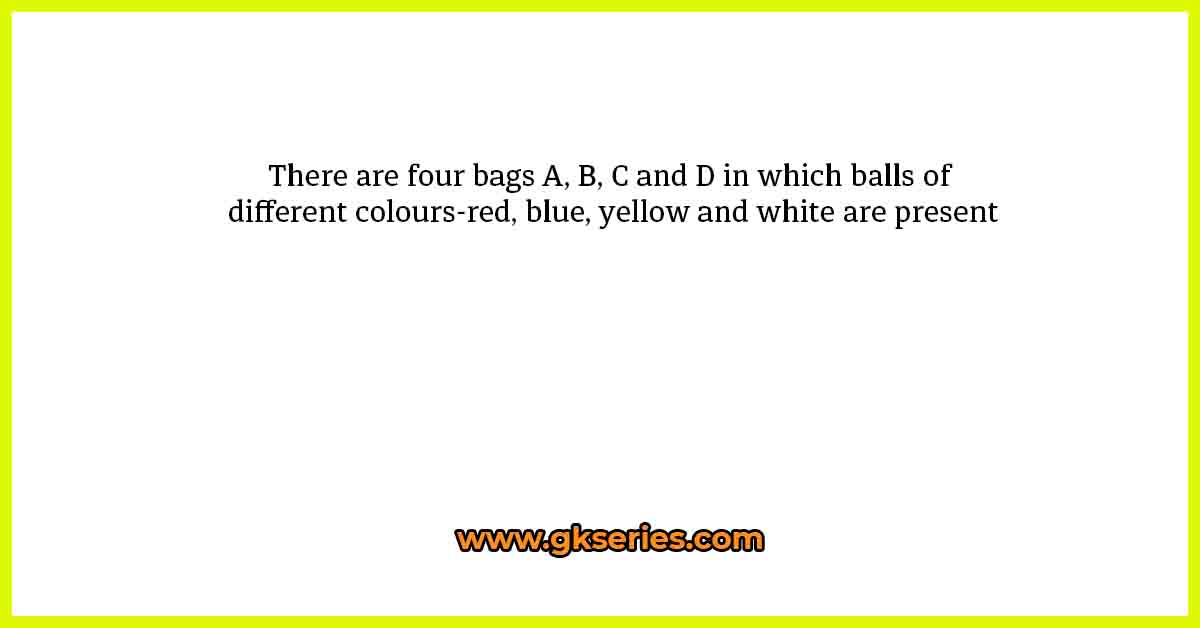
Direction: Read the following information carefully and answer the given questions:
There are four bags A, B, C and D in which balls of different colours-red, blue, yellow and white are present. The weight of a red ball, a blue ball, yellow ball and a white ball are 16 g, 20 g, 18 g and 24 g respectively. Total number of balls of all colourstogether is same in all the bags. Some information about the bags is given below:-
Bag A: Ratio of number ofred and blue balls is 5:4. Number of yellow balls is 9 more than red balls. Ratio of weight of blue and white balls is
10:13. Weight of all the yellow ballsin the bag is 432g.
Bag B: Percentage of blue balls in B is 50% more than blue balls in A. Ratio of weight of blue balls and yellow balls is 1:1. Total weight of yellow and red balls togetheris 552 gm.
Bag C: Number of red and blue balls together is
29 and number of blue and white balls togetheris 28. Probability of choosing a ball which is not white is 25/32.
Bag D: Number ofYellow balls are 10% more than blue balls. Number of white balls is 15. Probability of choosing a red ball or a white ball is 13/32.
Based on the information given, answer the questions that follow:
1) Some blue balls are transferred from bag A to bag B. If the balls were chosen at random, what is the probability of the weight of blue balls in B being at least 500g?
A) 7/12
B) 3/16
C) 25/76
D) Cannot be determined
E) 7/76
Sol:
Weight of blue balls in the bag B before transfer
from bag A=18*20=360g
Weight of each blue ball is 20g and after transfer
the weight increases by (500g-360g) i.e.,140g
which is equivalent to the weight of 7 balls.
So, 7 balls must be transferred from A to B.
But we don’t have any idea about how many
balls were transferred from A to B.
Thus, it cannot be discretely determined
2) 6 balls were transferred from bag B to bag C while 10 balls were transferred from bag D to bag C. P is the probability of choosing a blue ball at random. What are the minimum and maximum possible values of P?
A) 7/40, 3/8
B) 3/16, 3/8
C) 21/80, 37/80
D) 3/80,27/80
E) None of these
Sol:
For the minimum possible value of P, the case
must be that zero balls were transferred from
both bag B and bag D.
Also, after transfer of balls, total number of balls
in the bag=64+10+6=80
Minimum possible value of P=(no of blue
balls)/total no of balls =14/80=7/40
For the maximum possible value of P, both 6
balls transferred from B and 10 balls transferred
from D must be blue in colour.
=> Total number of blue balls after
transfer=14+6+10=30
Maximum possible value of P=30/80=3/8
3) In bag C, all the red balls were marked an odd number against them starting from 1 while the yellow balls were marked an even number against them starting from 2. If one red ball and one yellow ball are chosen at random from the bag, what is the probability of getting a sum of numbers present on the balls more than 10?
A) 61/63
B) 9/16
C) 7/16
D) 62/63
E) None of these
Sol:
In bag C, red balls=15 and they were marked
odd numbers 1,3,5,7,…… while yellow balls=21
and they were marked even numbers
2,4,6,8,10,………
So, total number of outcomes=15*21=315
Outcomes giving sum of less than 10 are (1,2),
(1,4), (1,6), (1,8), (3,2), (3,4), (3,6), (5,2), (5,4), (7,2).Total number of outcomes with sum of
numbers less than 10=10
=> Probability of getting sum of numbers less
than 10=10/315=2/63
Thus, probability of getting sum more than 10=1-
2/63=61/63
4) A man chose a ball at random from A and B each. What is the probability that the balls chosen have a combined weight more than 40g?
A) 15/64
B) 5/16
C) 3/8
D) 13/64
E) None of these
Sol:
Weight of the red ball, blue ball, yellow ball and
white ball are 16g, 20g, 18g and 24g
respectively.
Since there are four colours and one ball from
each bag is chosen at random, total number of
outcomes=4*4=16
Let R, B, Y and W denote trails of choosing a
red, blue, yellow and white ball respectively.
For sum of weights to be more than 40g,
possible outcomes are BW, WB, WY, YW and
WW
Required probability=5/16





